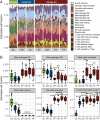Machine-learning-driven biomarker discovery for the discrimination between allergic and irritant contact dermatitis
- PMID: 33318199
- PMCID: PMC7776829
- DOI: 10.1073/pnas.2009192117
Machine-learning-driven biomarker discovery for the discrimination between allergic and irritant contact dermatitis
Abstract
Contact dermatitis tremendously impacts the quality of life of suffering patients. Currently, diagnostic regimes rely on allergy testing, exposure specification, and follow-up visits; however, distinguishing the clinical phenotype of irritant and allergic contact dermatitis remains challenging. Employing integrative transcriptomic analysis and machine-learning approaches, we aimed to decipher disease-related signature genes to find suitable sets of biomarkers. A total of 89 positive patch-test reaction biopsies against four contact allergens and two irritants were analyzed via microarray. Coexpression network analysis and Random Forest classification were used to discover potential biomarkers and selected biomarker models were validated in an independent patient group. Differential gene-expression analysis identified major gene-expression changes depending on the stimulus. Random Forest classification identified CD47, BATF, FASLG, RGS16, SYNPO, SELE, PTPN7, WARS, PRC1, EXO1, RRM2, PBK, RAD54L, KIFC1, SPC25, PKMYT, HISTH1A, TPX2, DLGAP5, TPX2, CH25H, and IL37 as potential biomarkers to distinguish allergic and irritant contact dermatitis in human skin. Validation experiments and prediction performances on external testing datasets demonstrated potential applicability of the identified biomarker models in the clinic. Capitalizing on this knowledge, novel diagnostic tools can be developed to guide clinical diagnosis of contact allergies.
Keywords: allergic contact dermatitis; artificial intelligence; biomarker; irritant contact dermatitis; machine learning.
Copyright © 2020 the Author(s). Published by PNAS.
Conflict of interest statement
The authors declare no competing interest.
Figures







References
-
- Keegel T., Moyle M., Dharmage S., Frowen K., Nixon R., The epidemiology of occupational contact dermatitis (1990-2007): A systematic review. Int. J. Dermatol. 48, 571–578 (2009). - PubMed
-
- Diepgen T. L., et al. , Prevalence of contact allergy in the general population in different European regions. Br. J. Dermatol. 174, 319–329 (2016). - PubMed
-
- Carøe T. K., Ebbehøj N. E., Bonde J. P., Agner T., Occupational hand eczema and/or contact urticaria: Factors associated with change of profession or not remaining in the workforce. Contact Dermat. 78, 55–63 (2018). - PubMed
-
- Moberg C., Alderling M., Meding B., Hand eczema and quality of life: A population-based study. Br. J. Dermatol. 161, 397–403 (2009). - PubMed
-
- Tan C. H., Rasool S., Johnston G. A., Contact dermatitis: Allergic and irritant. Clin. Dermatol. 32, 116–124 (2014). - PubMed
Publication types
MeSH terms
Substances
LinkOut - more resources
Full Text Sources
Other Literature Sources
Research Materials
Miscellaneous

